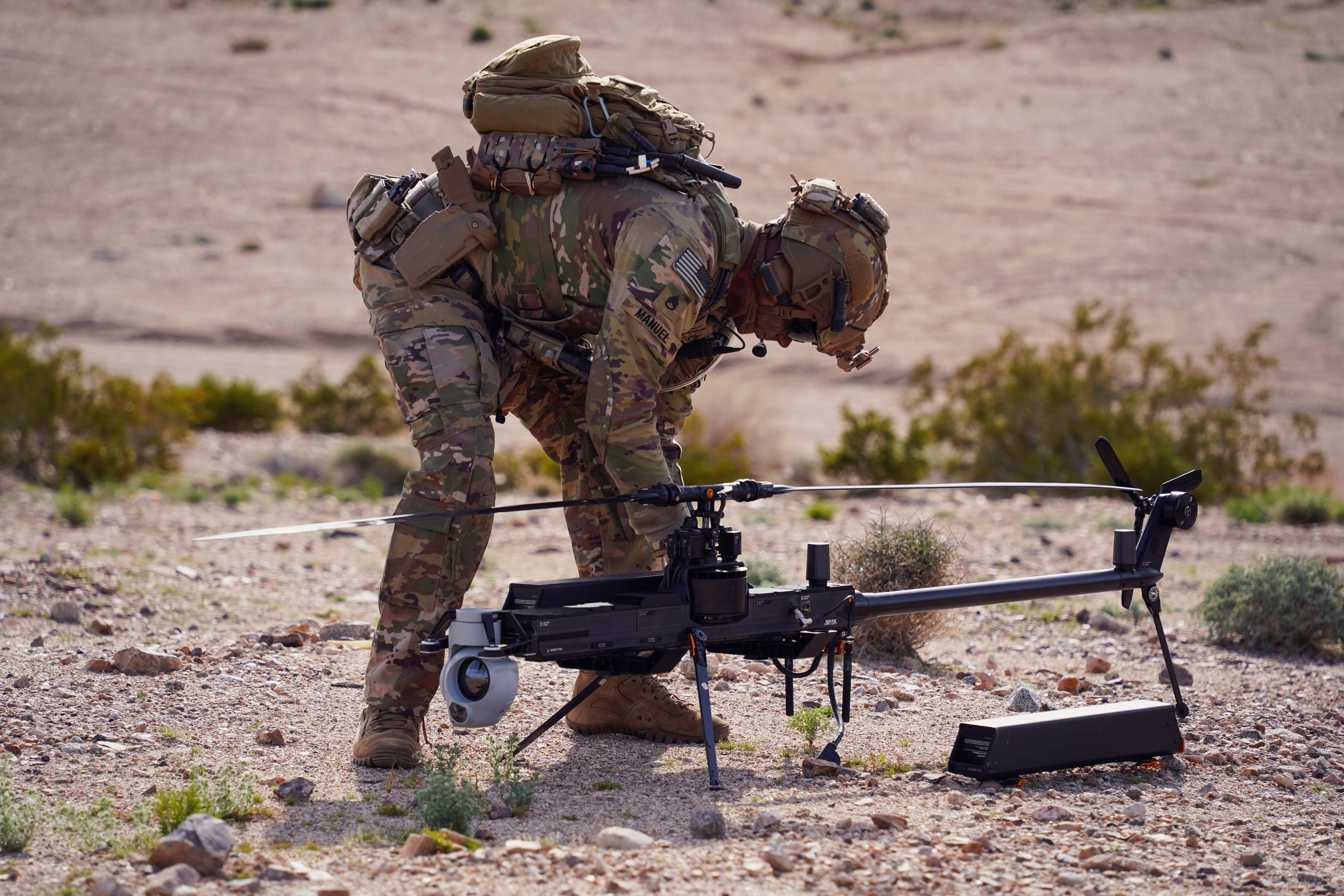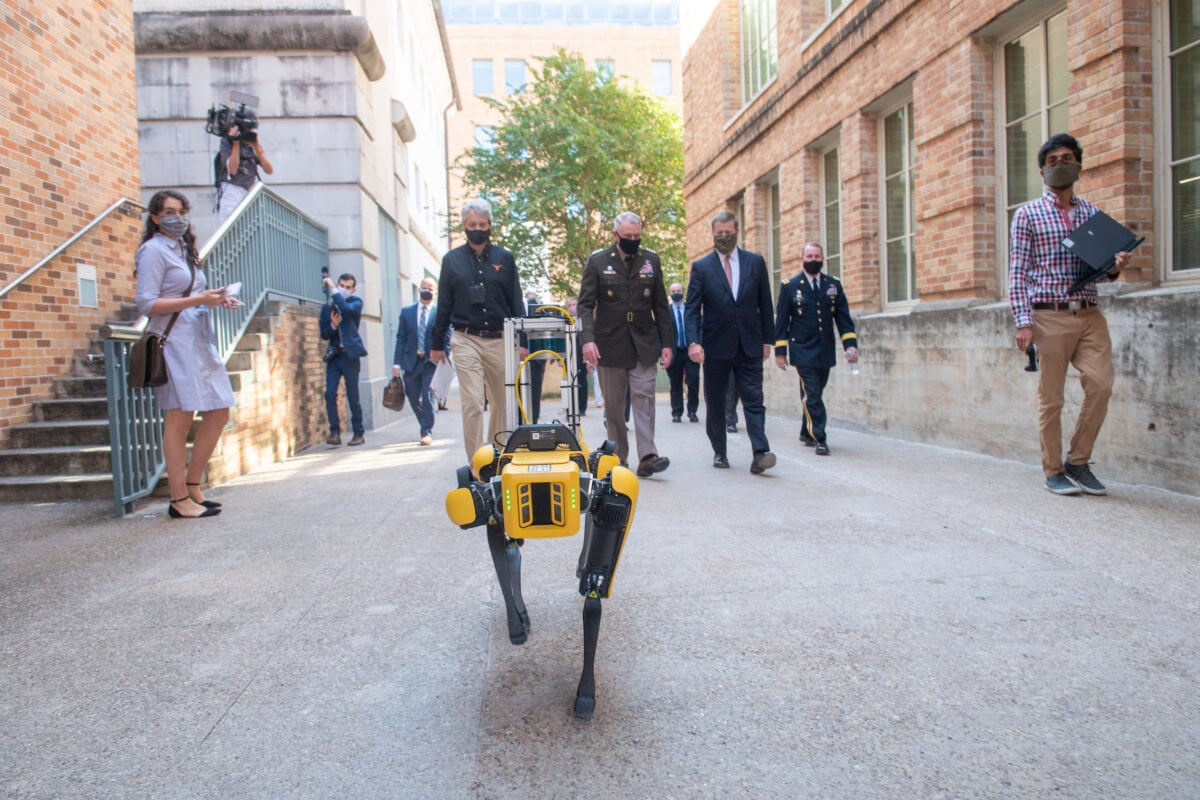Instead of welding tank treads by the thousands, the Detroit Arsenal in Warren, Michigan, is now 3D printing Patriot missile parts in weeks, advancing robotics and strapping virtual reality headsets on Army leadership to simulate how future weapons are being developed.
In World War II, Detroit, Michigan, became the “Arsenal of Democracy,” churning out tanks, jeeps and bombers. Now, 85 years later, Michigan is again pitching itself as America’s factory floor for the future of warfare — except this time, the tools of defense are drones powered by artificial intelligence and made with 3D-printed parts in record time.
Army Secretary Dan Driscoll paid a visit to Detroit on Friday, meeting with a slew of small companies working to break into the defense industry that has historically been reserved for major defense prime contractors.
Driscoll toured the Ground Vehicle Systems Center, or GVSC, with Democratic Sen. Elissa Slotkin, in her home state, along with a bipartisan group of other lawmakers.
“Basically 60% of what an Army soldier drives or shoots comes out of Michigan,” Slotkin told Defense News in an interview Friday. “We are a big producer and manufacturer for the Army and, of course, [the Army’s] transformation initiative went right to the heart of how [Driscoll] sees the force of the future,” she added.
“He saw everything from really cool programs of the future related to drones and tanks and ground vehicles,” Slotkin said of Driscoll’s visit. “He put on some [virtual reality] headsets and looked at one of our growing areas of expertise, which is modeling and simulation,” she noted, which helps to “shorten the string between having an idea and fielding it.”
Additionally, Driscoll toured a new incubator hub for defense technology in downtown Detroit called Newlab and met with a group of CEOs from participating companies, according to Slotkin.
Newlab, established less than a year ago, has grown into a half-mile expanse with over 150 companies, backed by a billion-dollar investment in the city’s Michigan Central Station. There, ideas move from pilot programs to manufacturing spaces to produce new defense technology, Slotkin explained.
“It’s the perfect marriage of Michiganders having the best manufacturing tradition in the country; fifth- and sixth-generation tradesmen, building precision tools with AI and tech of the future,” Slotkin said. “They’ve launched multimillion-dollar programs right out of downtown Detroit.”
The hub positions Michigan to level up with other states that are at the helm of fostering innovation and connecting smaller, nontraditional businesses with applicable technology to the defense industry, like Texas, where Army Futures Command is headquartered.
RELATED

Further, efforts like Newlab align with Driscoll’s position that success would be seeing a defense prime contractor being put out of business in the next two years and replaced by work done outside of what he considers the Pentagon’s famously sluggish acquisition system.
Driscoll has testified on the Hill and spoken at public events about innovation he’s seen coming from venture capital firms and tech companies like Palantir, Anduril, Applied Intuition and others at the forefront of areas like autonomy and AI.
Driscoll’s trip comes as the Army is trying to transform itself. Earlier this spring, the Army secretary released a memo announcing sweeping changes, such as restructuring commands and formations. Dubbed the Army Transformation Initiative, the effort cancels big, billion-dollar programs that no longer align with the Army’s strategy and commits to acquiring innovative technology needed on today’s battlefield as quickly as possible.
Shaking up industry
As part of the Army Transformation Initiative, the service made major decisions that would impact Michigan’s defense industry.
The Army decided to pull the plug on a light tank, for instance, built by General Dynamics Land Systems, headquartered in Sterling Heights. The vehicle, called the M10 Booker, was slated to enter full-rate production and was the first new combat vehicle to enter the force in four decades.
But the Army decided it was not needed even after the service had invested several billion dollars to develop and field the vehicle.
“This concept of sunk cost fallacy, it is a thing that human beings generally struggle with, which is if you’ve invested a lot in the past, and we do this in our personal lives, you get anchored to things that are suboptimal for the future,” Driscoll told Defense News in a June 9 interview at the Pentagon.

The Army has also decided to scale back orders that the program office for ground combat systems manages, such as the Armored Multipurpose Vehicle and the Paladin Improved Management (PIM) howitzer — both produced by BAE Systems. The company’s Sterling Heights facility is focused on land vehicle development and manufacturing.
The service is turning its eye toward lighter, more mobile capability and is going to invest heavily in the Infantry Squad Vehicle, developed by GM Defense in Michigan, to the tune of roughly $300 million. The vehicle was born in record time and has been gaining traction with soldiers in operational exercises globally.
The Army’s transformation initiative includes a roughly 38% reduction in ground system science and technology, to include a lump sum of work at the GVSC, and ends some programs altogether, such as the Robotic Combat Vehicle program.
Yet, the service plans to invest over $200 million in robotics development in its fiscal 2026 budget request to pursue autonomous capability rather than focus on specific vehicle platforms.
RELATED

The Army is also doubling down on its effort to rapidly develop and field a new variant of the Abrams tank, dubbed the M1E3, and remains fully committed to continuing a competition to build the XM30 Mechanized Infantry Combat Vehicle, a replacement for the Bradley Infantry Fighting Vehicle.
American Rheinmetall Vehicles, situated in Sterling Heights, and General Dynamics Land Systems are competing to design and build prototypes for the XM30 program.
A large portion of that development and design work will rely on modeling and simulation technology and other advanced manufacturing concepts emerging in Michigan.
Delivering at speed
GVSC is looking at innovations in manufacturing to not only look ahead to future capability but also ensure current weapons systems stay ready on the battlefield.
Slotkin said she and Driscoll learned that the center, for instance, had been able to reverse engineer tubing used to connect the Patriot air and missile defense system to a generator that was running into trouble in real-world operations, and then 3D printed it.
When problems with the system were cropping up in the Middle East, a schedule quote from the supplier to replace the tubing was 900 days, Slotkin recounted.
“You know how in demand Patriot systems are, that’s just insane,” she said.
The center was able to deliver the tubing in 45 days, according to Slotkin.
“900 days versus 45 days is what the speed of warfare is in 2025.”
Pivoting to focus on delivering capabilities at what military officials like to call the speed of relevance isn’t just about harnessing technology, but is also about ensuring policy and practices are in place to deliver.
“We have to be honest that Congress has a role in making [defense] acquisition really screwed up,” Slotkin said.
“[Driscoll] is very open about wanting to break down that tradition,” she noted. “I want to bring home good things to Michigan, but we want to compete on a level playing field. We can show off our grit and our determination. We’re not looking for a handout or just to live off of earmarks. We want to compete with Texas, or Alabama, or Louisiana on our merits.”
Jen Judson is an award-winning journalist covering land warfare for Defense News. She has also worked for Politico and Inside Defense. She holds a Master of Science degree in journalism from Boston University and a Bachelor of Arts degree from Kenyon College.
Read the full article here








Leave a Reply